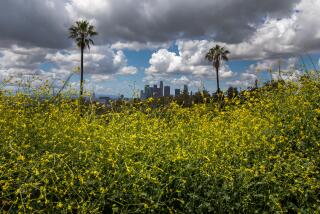BAMBOO
- Share via
Bamboo, a tall, tree-like member of the grass family, has long been cultivated as an ornamental plant in Southern California because of its striking, lance-shaped leaves and unusual stems.
But the dense thickets of bamboo (arundinaria) common in tropical regions of Asia and in the canebrakes of the southern United States are found here only in swamps, on stream banks and in wet bottomlands because of the plant’s need for moisture.
The bamboo forest pictured here, a rare sight in arid urban areas, is in the Hansen Dam flood control basin in Pacoima. Bamboo, which always grows in clumps, started growing in an area south of the dam after torrential rains brought tons of silt down from the hills in the late 1960s and early 1970s, causing a 130-acre recreational lake to shrink to its existing 30 acres.
Of the more than 200 species of bamboo, only the giant cane is native to North America. It reaches heights of up to 30 feet. When the giant cane flowers--as with many other bamboos, this happens only once every 40 to 50 years--it produces spikelets from 1 1/2 to 2 1/2 inches long. In the meantime, it propagates by underground stems, or rhizomes.






